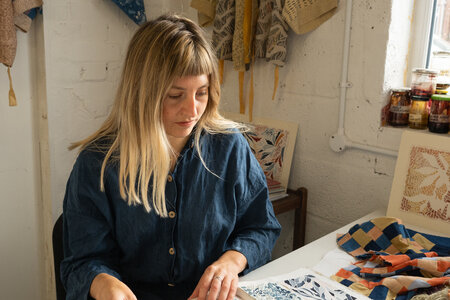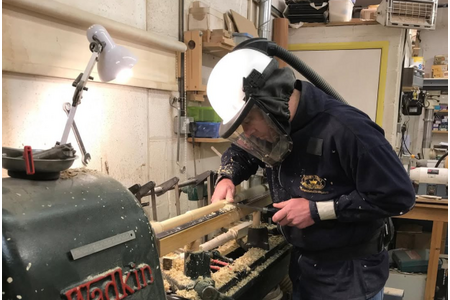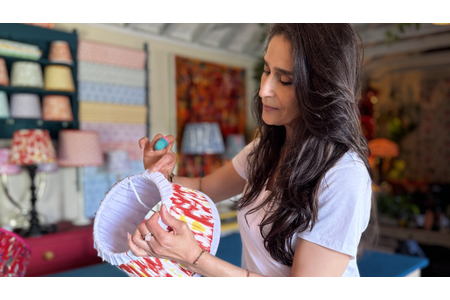Meet the Maker: Jenney Kelly
In this instalment of Meet the Maker, we introduce Jenney Kelly, a new tutor running a short course in traditional Indian block printing. Jenney’s love of travel influences her work, where she draws inspiration from local textiles and design, as well as learning first-hand from local craftspeople. In this interview we learn about what drew her to block printing and why she believes heritage craft such as block printing should be safeguarded.
Can you share a bit about your journey and how you got started as a block printer, bespoke textile maker and eco-dyer?
I have always had an interest in textiles, from upcycling fabrics, making tops from vintage embroidered tablecloths, cutting my own patterns, collecting fabrics & haberdashery, making soft furnishings and through to experimenting with pattern and print.
For some time, I’ve been making a range of bags and accessories from upcycled fabrics and Liberty velvets. Inspired by a short course on block printing, I began to block print my own fabrics at home, experimenting with a variety of textiles. My collection of blocks was growing along with my understanding and appreciation of the complexity and skill that goes into making each block- many are a work of art.
Aspiring to know more, I travel regularly to India to learn first-hand from the masters of this wonderful craft. There I’m able to source wooden and brass blocks, meet the block carvers and venture out into the more rural districts of Rajasthan to learn more advanced techniques and how to incorporate natural dyes into my work. I’ve also introduced them to printing on some less common fabrics such as antique hemp sheets, noil silk or velvet.
Having bought a ‘sacred blessing throw’ created from dyes and prints with cast-off, blessed temple flowers (Nirmalya), I contacted Rupa Trivedi, founder of the Temple Dye Project and Temple Blessings Textiles. She explained how each panel of the throw had been printed using marigold, hibiscus and rose and this is what inspired me to learn more.
After attending an eco printing course at West Dean, I started printing at home using plants and flowers from my garden, and then introduced natural dyes, such as madder, weld, brazilwood and logwood, which add another dimension to the prints.
Nothing goes to waste – the by-products such as the ‘blanket’, dye bath, silk ribbon and organic cotton string are all saved and used for other purposes.
Can you share a memorable experience or moment in your career?
My collection of antique hop or grain sacks has grown over the years – the uniqueness makes them irresistible! I’ve many beautiful, hand embroidered and monogrammed sacks, which date back many decades, with the initials identifying the family name along with a personalized stripe running down the length. I started to make tote bags, using the coloured stripes and monogram as a feature. I was absolutely delighted when the Editor of Country Living magazine contacted me and wanted to feature one of my bags in their magazine.
What inspires your work?
We are surrounded by colour, texture and pattern in every aspect of our day-to-day life, so anything can spark an idea! Like most people, I always have my phone/camera at hand, so capturing something in the moment is instant and easy. This could be anything from some beautiful tree bark to a man-made material or structure.
I love travel and this is a huge influence - I draw inspiration from local textiles and design. During a trip to Porto, I was inspired by the beautiful decorative ceramic tiles called Azulejos, which I developed into a repeatable design, and commissioned a block which I can print with.
Why do you believe courses in heritage craft skills, such as block printing, are so important in ensuring their viability and future?
Block printing is classified as an endangered craft by the Heritage Crafts, and is currently on their ‘red list’.
Although it’s believed there are sufficient craftspeople to pass on their knowledge to the next generation, there are serious concerns about the long-term viability due to the rapid advances of modern technology and manufacturing.
One of the best ways to raise awareness and safeguard any heritage craft, including block printing, is through education and engaging in practical and fun ‘hands-on’ experience, which is why you’re reading this!
I volunteer at a local heritage railway, restoring the upholstery of vintage carriages to their former glory using traditional materials such as moquette, horsehair and spring. It’s very hands-on, sometimes physically challenging, but hugely rewarding and hopefully one day I will be handing my skills onto a younger generation and preserving another heritage craft for the future.
Can you share five reasons someone should try block printing for the first time?
1) I often hear from my students that they’ve come across carved printing blocks but didn’t quite know how to use them... …for anyone who has found themselves asking this question, this is the perfect introduction to learn about the blocks and how to print with them
2) Exploring a new craft is uplifting and enjoyable – block printing is ideal for anyone either with no previous experience or for those who would like to learn more
3) If you have a passion for colour, pattern and texture, this is the perfect opportunity to experiment and to create your own unique textiles
4) Being a hands-on learning experience, you’ll find the session satisfying and therapeutic
5) Even if you don’t consider yourself ‘artistic’, you’ll walk away with something you have created!
You are teaching the short course ‘Traditional Indian block printing’ at West Dean this winter – what can students expect from this course?
You will get an introduction to the history and significance of block printing, with examples of different types of blocks, how they’re made and various fabric samples which have been hand block printed using traditional techniques
You’ll be introduced to the materials & tools available, including the inks, blocks, fabrics and paper
Following a demonstration on how to ink the blocks and print with them, there will be ample time to practice first on paper and then fabric, experimenting with a variety of colours and designs; combining blocks, exploring various pattern repeat options & spacing
You will then make a start on printing a set of khadi paper cards and drawstring pouch to store them in before focusing on how to design and plan the finished piece, first practicing your design on a sample piece of cotton before printing a linen table runner
You’ll have ample opportunity to ask questions throughout the workshop and while the work is drying, we shall discuss how to ‘fix’ your prints (this means making them colour-fast and enduring).
By the end of the workshop, you will have an understanding of how to choose and prepare suitable fabrics, produce simple block printed designs on your own textiles and how to fix your products for longevity.








